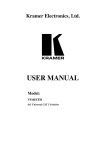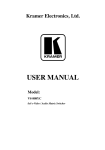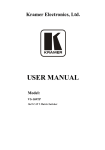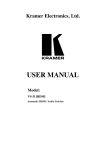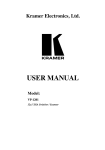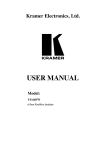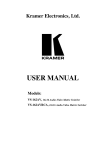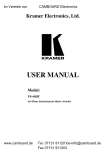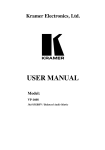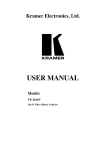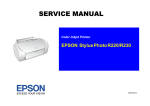Download User Manual for 8x8 VGA/UXGA Matrix Switcher - AV-iQ
Transcript
Kramer Electronics, Ltd. USER MANUAL Model: VP-8x8 8x8 VGA / UXGA Matrix Switcher Contents Contents 1 2 3 4 5 5.1 5.2 5.3 5.4 5.5 Introduction Getting Started Overview Your VP-8x8 8x8 VGA / UXGA Matrix Switcher Connecting the VP-8x8 Connecting the VP-8x8 Rear Panel Controlling via RS-232 (for example, using a PC) Controlling via RS-485 Control Configuration via the Ethernet Port Setting the Ethernet Port and Utilities 1 1 2 2 5 5 7 8 9 9 5.5.1 5.5.2 5.5.3 5.5.4 5.5.5 5.5.6 Connecting the VP-8x8 Ethernet port Installing and Running the XPort Configuration Software Configuring the Ethernet Port Using the Web Manager Page Controlling a Machine using the Com Port Redirector Using the Com Port Redirector 9 11 14 14 18 23 5.6 Setting the Dipswitches 24 5.6.1 5.6.2 Setting the Delay Setting the Machine # Dipswitches 24 25 5.7 6 6.1 6.2 Cascading Machines Operating the VP-8x8 Displaying Unit Characteristics Confirming Settings 25 26 27 27 6.2.1 6.2.2 Toggling between the At Once and Confirm Modes Confirming a Switching Action 28 28 6.3 Storing/Recalling Input/Output Configurations 28 6.3.1 6.3.2 6.3.3 Storing an Input/Output Configuration Recalling an Input/Output Configuration Deleting an Input/Output Configuration 29 29 29 6.4 7 7.1 7.2 7.3 8 9 10 Locking the Front Panel Flash Memory Upgrade Downloading from the Internet Connecting the PC to the RS-232 Port Upgrading Firmware Technical Specifications Table of Hex Codes for Serial Communication Kramer Protocol 2000 30 31 31 31 31 37 38 39 i Contents Figures Figure 1: VP-8x8 8x8 VGA / UXGA Matrix Switcher – Front and Rear View Figure 2: VP-8x8 8x8 VGA / UXGA Matrix Switcher – Underside View Figure 3: Connecting the VP-8x8 8x8 VGA / UXGA Matrix Switcher Figure 4: Connecting a PC without using a Null-modem Adapter Figure 5: Controlling via RS-485 (for example, using an RC-3000) Figure 6: Local Area Connection Properties Window Figure 7: Internet Protocol (TCP/IP) Properties Window Figure 8: XPort™ Installer Main Dialog Box Figure 9: Device Found on the Network Figure 10: IP Address Assignment Dialog Box Figure 11: Ethernet Port Web-Manager Figure 12: Server Configuration in the Unit Configuration Window Figure 13: Port Configuration in the Unit Configuration Window Figure 14: Server Properties in the Unit Configuration Window Figure 15: Serial Port Settings Window Figure 16: Dedicated Connection Window Figure 17: Flush Mode Input Buffer Window Figure 18: Com Port Redirector Welcome Screen Figure 19: Setup Complete Dialog Box Figure 20: Com Port Redirector Configuration Window Figure 21: Port Setup Window Figure 22: IP Service Setup Dialog Box Figure 23: Port Settings Window Figure 24: Silent Mode Checked in the RDCfg Window Figure 25: VP-8x8 Dipswitches Figure 26: Control Configuration via RS-232 and RS-485 Figure 27: VP-8x8 Unit Characteristics Figure 28: Storing and Recalling using the Input/Output Buttons Figure 29: Splash Screen Figure 30: Atmel – Flip Window Figure 31: Device Selection Window Figure 32: Selecting the Device from the Selection Window Figure 33: Loading the Hex Figure 34: RS-232 Window Figure 35: Atmel – Flip Window (Connected) Figure 36: Atmel – Flip Window (Operation Completed) ii 3 3 6 7 8 10 10 12 12 13 14 15 16 16 17 17 17 18 19 19 20 21 22 23 24 26 27 28 32 32 33 33 34 34 35 36 KRAMER: SIMPLE CREATIVE TECHNOLOGY Contents Tables Table 1: Front Panel VP-8x8 8x8 VGA / UXGA Matrix Switcher Features Table 2: Rear Panel VP-8x8 8x8 VGA / UXGA Matrix Switcher Features Table 3: VP-8x8 Underside Panel Features Table 4: Crossover Cable RJ-45 PINOUT Table 5: Straight-through Cable RJ-45 PINOUT Table 6: Web Manager Window Buttons Table 7: Port Settings Description Table 8: Dipswitch Settings Table 9: DELAY Dipswitch Settings Table 10: Machine # Dipswitch Settings Table 11: Technical Specifications of the VP-8x8 8x8 Video Audio Matrix Switcher Table 12: VP-8x8 Hex Codes for Switching via RS-232/RS-485 Table 13: Protocol Definitions Table 14: Instruction Codes for Protocol 2000 4 4 4 9 11 15 22 24 24 25 37 38 39 40 iii Introduction 1 Introduction Welcome to Kramer Electronics (since 1981): a world of unique, creative and affordable solutions to the infinite range of problems that confront the video, audio and presentation professional on a daily basis. In recent years, we have redesigned and upgraded most of our line, making the best even better! Our 350-plus different models now appear in 8 Groups1, which are clearly defined by function. Congratulations on purchasing your VP-8x8 8x8 VGA / UXGA Matrix Switcher, which is ideal for the following typical applications: Any professional display system requiring a true 8x8 computer graphics matrix operation Multimedia and presentation source, and acceptor selection The package includes the following items: VP-8x8 8x8 VGA / UXGA Matrix Switcher Power cord and Null-modem adapter Windows®-based Kramer control software2 Windows®-based Configuration Manager XPort software and Com Port Redirector Kramer RC-IR1 Infra-Red Remote Control Transmitter3 (including the required battery and a separate user manual4) This user manual4 2 Getting Started We recommend that you: Unpack the equipment carefully and save the original box and packaging materials for possible future shipment Review the contents of this user manual Use Kramer high performance high resolution cables5 1 GROUP 1: Distribution Amplifiers; GROUP 2: Video and Audio Switchers, Matrix Switchers and Controllers; GROUP 3: Video, Audio, VGA/XGA Processors; GROUP 4: Interfaces and Sync Processors; GROUP 5: Twisted Pair Interfaces; GROUP 6: Accessories and Rack Adapters; GROUP 7: Scan Converters and Scalers; and GROUP 8: Cables and Connectors 2 Downloadable from our Web site at http://www.kramerelectronics.com 3 Previously known as the IR-1 / IR-1-01 4 Download up-to-date Kramer user manuals from our Web site at http://www.kramerelectronics.com 5 The complete list of Kramer cables is on our Web site at http://www.kramerelectronics.com 1 Overview 3 Overview The VP-8x8 is a high performance 8x8 RGBHV Matrix Switcher for high resolution video. The VP-8x8 lets you simultaneously route any or all of the 8 inputs to any or all of the 8 outputs. The VP-8x8 8x8 VGA / UXGA Matrix Switcher: Has a video bandwidth of 400MHz that ensures transparent performance even in the most critical applications Has 16 preset memory locations for quick access to common configurations Has a delayed switching mode (ranging from 0 to 3.5sec1) for clean transitions (seamless switching) when switching between non-genlocked sources Has DC coupled inputs and outputs Includes a TAKE button, which allows you to place multiple switches in a queue and then activate them simultaneously with one touch of this button Consists of a LOCK button to prevent tampering with the front panel Automatically detects connected input signals (respective button illuminates) Control the VP-8x8 using the front panel buttons, or remotely via: RS-485 or RS-232 serial commands transmitted by a touch screen system, PC, or other serial controller The Kramer Infra-Red remote control transmitter Ethernet The VP-8x8 is dependable, rugged, and fits into one vertical space (1U) of a standard 19” professional rack2. To achieve the best performance: Connect only good quality connection cables, thus avoiding interference, deterioration in signal quality due to poor matching, and elevated noise levels (often associated with low quality cables) Avoid interference from neighboring electrical appliances that may adversely influence signal quality and position your Kramer VP-8x8 away from moisture, excessive sunlight and dust 4 Your VP-8x8 8x8 VGA / UXGA Matrix Switcher Figure 1, Table 1 and Table 2 define the VP-8x8 8x8 VGA / UXGA Matrix Switcher. Figure 2 illustrates the underside of the VP-8x8 unit, and Table 3 defines the underside features. 1 In increments of 0.5sec 2 The RGBHV signals are connected on HD15 pin connectors to reduce enclosure size 2 KRAMER: SIMPLE CREATIVE TECHNOLOGY Your VP-8x8 8x8 VGA / UXGA Matrix Switcher Figure 1: VP-8x8 8x8 VGA / UXGA Matrix Switcher – Front and Rear View Enlarged View Figure 2: VP-8x8 8x8 VGA / UXGA Matrix Switcher – Underside View 3 Your VP-8x8 8x8 VGA / UXGA Matrix Switcher Table 1: Front Panel VP-8x8 8x8 VGA / UXGA Matrix Switcher Features # Feature 1 IR Receiver 2 3 POWER Switch IN SELECTOR Buttons 4 5 6 OUT SELECTOR Buttons ALL Button OFF Button 7 TAKE Button 8 9 STO (Store) Button RCL (Recall) Button 10 11 LOCK Button STATUS 7-segment Display Function The red LED is illuminated when receiving signals from the Infra-red remote control transmitter Illuminated switch for turning the unit ON or OFF Select the input to switch to the output. When a signal is detected, the input button illuminates in green Select the output to which the input is switched 1 Pressing ALL followed by an INPUT button, connects that input to all outputs Press an OUT SELECTOR button and then an OFF button to disconnect that output from the inputs Press the ALL button and then the OFF button to disconnect all the outputs 2 Pressing TAKE toggles the mode between the Confirm mode and the At Once mode (user confirmation per action is unnecessary) 3 Pressing STO followed by an input/output button stores the current setting Pressing the RCL button and the corresponding IN/OUT button recalls a setup from the non-volatile memory. The stored status blinks. Pressing a different IN/OUT button lets you view4 another setup. After making your choice, pressing the RCL button again implements the new status Disengages the front panel switches Displays the selected input switched to the output (marked above each input)5 Table 2: Rear Panel VP-8x8 8x8 VGA / UXGA Matrix Switcher Features # Feature Function 12 13 14 HD15F INPUT Connectors HD15F OUTPUT Connectors FLASH PROG Button 15 16 RS-232 DB 9F Port DELAY and SETUP Dipswitches 17 ETHERNET Connector 18 19 RS-485 Terminal Block Port Power Connector with Fuse Connect to the video sources (from 1 to 8) Connect to the output acceptor (from 1 to 8) Push in for “Program” to upgrade to the latest Kramer firmware (see section 7), or release for Normal (the factory default)6 Connects to the PC or the Remote Controller Dipswitches for setup of the unit (DELAY dips 1, 2, 3 are for setting the delay time; SETUP dips 1, 2, 3, 4 are for setting machine #; 8 is for RS-485 Termination) Connects to the PC or other Serial Controller through computer networking Pin G is for Ground connection; Pins B (-) and A (+) are for RS-485 AC connector enabling power supply to the unit Table 3: VP-8x8 Underside Panel Features # 1 Feature RESET FOR PROGRAM Button Function Press to reset unit prior to firmware upgrade (see section 7.3) 1 For example, press ALL and then Input button # 2 to connect input # 2 to all the outputs 2 When in the Confirm mode, the TAKE button illuminates 3 For example, press STO and then the Output button # 3 to store in Setup # 3 4 Only view, nothing is implemented at this stage 5 Also displays the number of IN and OUT ports, the firmware version number, and the MACHINE #. Refer to section 6.1 6 The FLASH PROG “Reset” button is located on the underside of the unit 4 KRAMER: SIMPLE CREATIVE TECHNOLOGY Connecting the VP-8x8 5 Connecting the VP-8x8 This section describes how to: Connect the VP-8x8 rear panel (see section 5.1) Connect the VP-8x8 to a controlling device via RS-232 (see section 5.2), RS-485 (see section 5.3) and/or the Ethernet (see sections 5.4 and 5.5) Set the dipswitches (see section 5.6) Connect several VP-8x8 machines (see section 5.7) 5.1 Connecting the VP-8x8 Rear Panel To connect the VP-8x8, do the following1: 1. Connect up to 8 VGA/UXGA computer graphics sources to the input connectors (see the illustration in Figure 3). 2. Connect2 the 8 output connectors to up to 8 VGA/UXGA video acceptors3. 3. Set the dipswitches (see section 5.4). 4. Connect a PC and/or controller (if required) to the RS-232 port (see section 5.2) and/or RS-485 port (see section 5.3). 5. Connect the power cord4. 1 Switch OFF the power on each device before connecting it to your VP-8x8. After connecting your VP-8x8, switch on its power and then switch on the power on each device. DO NOT push in the rear panel Flash Program “Program” button (item 9 in Table 2) and DO NOT push in the underside Flash Program “Reset” button. These are only used for upgrading to the latest Kramer firmware (see section 7) 2 When less than eight outputs are required, connect only those outputs of the VP-8x8 that are required, and leave the other outputs unconnected 3 Displays or projectors 4 We recommend that you use only the power cord that is supplied with this machine 5 Connecting the VP-8x8 RS-232 Computer Graphics Source 1 Display 1 Computer Graphics Source 8 Display 8 Figure 3: Connecting the VP-8x8 8x8 VGA / UXGA Matrix Switcher 6 KRAMER: SIMPLE CREATIVE TECHNOLOGY Connecting the VP-8x8 5.2 Controlling via RS-232 (for example, using a PC) To connect a PC to the VP-8x8 unit, using the Null-modem adapter provided with the machine (recommended): Connect the RS-232 DB9 rear panel port on the Master VP-8x8 unit to the Null-modem adapter and connect the Null-modem adapter with a 9-wire flat cable to the RS-232 DB9 port on your PC To connect a PC to the VP-8x8 unit, without using a Null-modem adapter: Connect the RS-232 DB9 port on your PC to the RS-232 DB9 rear panel port on the Master VP-8x8 unit, as Figure 4 illustrates (depending on whether the PC has a 9-pin or 25-pin connector) Figure 4: Connecting a PC without using a Null-modem Adapter 7 Connecting the VP-8x8 5.3 Controlling via RS-485 You can control a VP-8x8 unit via an RS-485 controller, for example, a PC (equipped with an RS-485 interface) or a Master Programmable Remote Control system such as the Kramer RC-30001. To connect an RC-3000 to a VP-8x8 unit (see Figure 5): 1. Connect the RS-485 terminal block port on the RC-3000 to the RS-485 port on the VP-8x8 unit, as follows: Connect the “ A” (+) PIN on the RS-485 rear panel port of the RC-3000 to the “ A” (+) PIN on the RS-485 rear panel port of the VP-8x8 unit Connect the “ B” (-) PIN on the RS-485 rear panel port of the RC-3000 to the “ B” (-) PIN on the RS-485 rear panel port of the VP-8x8 unit If shielded twisted pair cable is used, the shield may be connected to the “ G” (Ground) PIN on one of the units (for example, on the RC-3000) 2. Set the VP-8x8 unit as Machine # 1, according to Table 10 (that is, DIP 1, DIP 2, DIP 3, and DIP 4 OFF), and set the other dipswitches on the VP-8x8 unit, as follows: Set DIP 5, DIP 6, and DIP 7 OFF Set DIP 8 ON (for RS-485 Line Termination with 120 ) RS-485 PINOUT G _ B + A KEYBOARD EXTENSION OU T IN 1 2 3 4 5 6 7 8 9 10 11 12 13 14 15 16 REMOTE CONTACT 1 2 3 4 5 6 7 8 G RS-485 RS-232 IN RS-232 OUT 12 VDC Figure 5: Controlling via RS-485 (for example, using an RC-3000) 1 Previously known as the VS-3000 8 KRAMER: SIMPLE CREATIVE TECHNOLOGY Connecting the VP-8x8 5.4 Control Configuration via the Ethernet Port To control several units via the Ethernet connect the Master unit (Machine # 1) via the Ethernet port to the LAN port of your PC. Using your PC, initially configure the settings as described in section 5.5. 5.5 Setting the Ethernet Port and Utilities To control your VP-8x8 via the Ethernet, perform an initial configuration as follows: 1. Connect the Ethernet port of the VP-8x8 to the LAN port of your PC (see section 5.5.1). 2. Configure your Ethernet Port (see section 5.5.2). 3. Install the COM Port Redirector to control the VP-8x8 (see section 5.5.5). 5.5.1 Connecting the VP-8x8 Ethernet port You can connect the Ethernet port either via a crossover cable (see section 5.5.1.1) or a straight through cable (see section 5.5.1.2). 5.5.1.1 Connecting via a Crossover Cable Connect the Ethernet port of the VP-8x8 to the LAN port on your PC, via a crossover cable with RJ-45 connectors, as Table 4 defines. Table 4: Crossover Cable RJ-45 PINOUT Side 1 PIN 1 2 3 4 5 6 7 8 Wire Color White-orange Orange White-green Blue White-blue Green White-brown Brown Side 2 PIN 1 2 3 4 5 6 7 8 Wire Color White-green Green White-orange Blue White-blue Orange White-brown Brown This type of connection is recommended for identification of the factory default IP Address of the VP-8x8 during the initial configuration 9 Connecting the VP-8x8 After connecting the Ethernet port, configure your PC as follows: 1. Right-click the My Network Places icon on your desktop. 2. Select Properties. 3. Right-click Local Area Connection Properties. 4. Select Properties. The Local Area Connection Properties window appears. 5. Select the Internet Protocol (TCP/IP) and click the Properties Button (see Figure 6). Figure 6: Local Area Connection Properties Window 6. Select Use the following IP Address, and fill in the details as shown in Figure 7. 7. Click OK. Figure 7: Internet Protocol (TCP/IP) Properties Window 10 KRAMER: SIMPLE CREATIVE TECHNOLOGY Connecting the VP-8x8 5.5.1.2 Connecting via a Straight-Through Cable If connecting the Ethernet port of the VP-8x8 to the LAN port on a network hub or network router, use a straight-through cable with RJ-45 connectors, as Table 5 defines: Table 5: Straight-through Cable RJ-45 PINOUT Side 1 PIN 1 2 3 4 5 6 7 8 5.5.2 Side 2 Wire Color White-orange Orange White-green Blue White-blue Green White-brown Brown PIN 1 2 3 4 5 6 7 8 Wire Color White-orange Orange White-green Blue White-blue Green White-brown Brown Installing and Running the XPort Configuration Software To configure the Ethernet Port, you have to install and run the XPort configuration software. It is important to consider the following points before logging into and configuring the Ethernet Port: The VP-8x8 IP address must be configured before a network connection is available Only one person at a time may be logged into the network port. This eliminates the possibility of several people simultaneously attempting to configure the Device Server Network port logins can be disabled. The system manager will not be able to access the unit. This port can also be password protected 5.5.2.1 Install XPort™ Installer To install the XPort™ Installer, do the following: 1. Insert the product CD into your CD-ROM drive. 2. Run the XPort installer setup. 3. Respond to the installation wizard prompts. 4. Restart your system. 11 Connecting the VP-8x8 5.5.2.2 Run XPort™ Installer Click the Start button on the Task Bar and select Programs\XPort Installer\XPort Installer. The XPort™ Installer main dialog box displays (Figure 8). Figure 8: XPort™ Installer Main Dialog Box To search for devices, click the Search icon or select Search Network from the Action menu. 5.5.2.3 Assign IP Address Figure 9 shows a device found on the network, with the IP addresses assigned at the factory. The Hardware Address is an individual permanent address assigned to a particular device on the network. The Hardware Address can be found on the product label inside the unit. Note: Click on a device to view its attributes Figure 9: Device Found on the Network 12 KRAMER: SIMPLE CREATIVE TECHNOLOGY Connecting the VP-8x8 To change the IP address, first select the device from the list, then click the Assign IP icon or select Assign IP Address from the Action menu. The hardware address and IP address are loaded into the Assign IP Address dialog box (Figure 10). Figure 10: IP Address Assignment Dialog Box Enter the new IP Address and click OK. The new IP Address will appear in the main window. 5.5.2.4 Test the IP Address To test the IP Address, do the following: 1. Select the device from the main window list. 2. Click the Ping icon or select Ping from the Action menu. The Ping Device dialog box shows the IP Address of the selected device. 3. Click the Ping button and the results will be displayed in the Status window. Use the Clear Status button to clear the window so you can ping the device again. 4. Click the Close button to close the dialog box and return to the main window. Note: If you do not receive “Reply” messages, make sure the unit is properly attached to the network and that the IP address assigned is valid for the particular network segment you are working with. If you are not sure, check with your Systems Administrator 13 Connecting the VP-8x8 5.5.3 Configuring the Ethernet Port You must configure the Ethernet Port so that it can communicate on a network with your serial device. For example, you must set the way the unit will respond to serial and network traffic, how it will handle serial packets, and when to start or close a connection. You can configure your unit locally or remotely using the following procedures: Use the XPort™ Installer to configure the unit. Some features are only available through the XPort™ Installer menus Use a standard Web browser to access the unit’s internal Web pages and configure the unit over the network (see section 5.5.4) This is the easiest and preferred method Make sure that the Java™ 2 Runtime Environment (Standard Edition Version 1.4.1) software is installed on your PC. If not, download it from: http://java.sun.com The unit’s configuration is stored in non-volatile memory and is retained without power. You can change the configuration at any time. The unit performs a reset after the configuration has been changed and stored. 5.5.4 Using the Web Manager Page To configure the Ethernet Port via a Web browser, first click one of the devices listed in the window, and then click the Web icon. The Web-Manager window now displays in your browser. Figure 11: Ethernet Port Web-Manager 14 KRAMER: SIMPLE CREATIVE TECHNOLOGY Connecting the VP-8x8 Table 6 describes the Web Manager window buttons. Table 6: Web Manager Window Buttons Button Function Unit Configuration Press to enter the Server Configuration and the Port Configuration settings (section 5.5.4.1) Server Properties Press to enter the Server Properties and change the server properties by editing any of the fields (section 5.5.4.2) Port Properties Press to enter the Port Properties and modify them Factory Settings1 Press to set to factory default settings Update Settings Press to update settings Channel 1 Disabled When in the Web Manager window: 1. Use the menu buttons to navigate to sub pages where you can configure server settings. See explanations of the configuration parameters in the following sections. 2. When you are finished, click the Update Settings button to save your settings. 5.5.4.1 Unit Configuration Button Click the Unit Configuration button to display the following dialog box (Figure 12). This page contains the Server Configuration and the Port Configuration settings. These are static settings read from the device. Figure 12: Server Configuration in the Unit Configuration Window Figure 12 and Figure 13 show the information available in the Unit Configuration window. 15 Connecting the VP-8x8 Figure 13: Port Configuration in the Unit Configuration Window 5.5.4.2 Server Properties Button Click the Server Properties button to display the following dialog box (see Figure 14). You can change the server properties by editing any of the fields. Hold the cursor over one of the fields to display Help messages. Figure 14: Server Properties in the Unit Configuration Window Changing the IP address will require you to enter the new IP address in the browser to reload the page In the Telnet Password field, enter a password to prevent unauthorized access to the Setup Mode via a Telnet connection to port 9999. The password is limited to 4 characters. (An enhanced password setting of 16 characters is available under Security Settings on the Telnet Setup Mode window) 16 KRAMER: SIMPLE CREATIVE TECHNOLOGY Connecting the VP-8x8 5.5.4.3 Port Properties Button Click the Port Properties button to display the following dialog boxes. Make sure that the Serial Port Settings window is set according to Figure 151. Figure 15: Serial Port Settings Window Make sure that the Local Port in the Dedicated Connection window is set according to Figure 16. Figure 16: Dedicated Connection Window Make sure that the Flush Mode Input buffer window is set according to Figure 17. Figure 17: Flush Mode Input Buffer Window 1 You can change the server properties by selecting the desired properties from the drop down list 17 Connecting the VP-8x8 5.5.5 Controlling a Machine using the Com Port Redirector The Com Port Redirector allows any PC running Windows to use ports on a network server as if they were connected directly to the PC. The Redirector creates a virtual COM port within Windows, which for most purposes acts just like the selected serial port on the server. 5.5.5.1 Installing the Com Port Redirector To install the Com Port Redirector, do the following: 1. Perform the appropriate step to start the installation: If the Com Port Redirector is on a CD-ROM, insert the CD-ROM into the computer’ s CD-ROM drive If you downloaded the Com Port Redirector, double-click the downloaded file Either step displays the Redirector - Welcome screen in Figure 18 Figure 18: Com Port Redirector Welcome Screen 2. Click the Continue button and follow the on-screen installation instructions. 3. After installation, the Setup Complete dialog box appears (Figure 19). 18 KRAMER: SIMPLE CREATIVE TECHNOLOGY Connecting the VP-8x8 Figure 19: Setup Complete Dialog Box 4. Click Finish to complete the installation and restart your computer. 5. Click the Start button in the Windows Taskbar, point to Programs, point to Lantronix Redirector, and click Configuration. The Com Port Redirector Configuration window appears (see Figure 20). Figure 20: Com Port Redirector Configuration Window 6. Click the Com Setup button. A Port Setup dialog box appears (Figure 21), with the first logical communications port checked. The physical communication ports on the computer where the Com Port Redirector is installed are grayed-out and unavailable. In Figure 21, these are Com1 through Com3. Your unavailable communication ports may vary. 19 Connecting the VP-8x8 Figure 21: Port Setup Window 7. Click all the logical ports to which the PC will be redirected. A checkmark appears next to each logical port selected. Each port selected will be available from the Redirect To drop-down list in the Com Port Redirector Configuration window (see Figure 20). 8. To deselect a port, click it again to remove the checkmark next to it. Removing the checkmark indicates that the port will not be available from the Redirect To drop-down list. 9. When finished, click OK. Note: After you use the Port Setup dialog box to add or remove Com ports, restart your computer 5.5.5.2 Configuring the Com Port Redirector Com Port Redirector is a software utility for network-enabling legacy software applications that do not have network support. Com Port Redirector installs virtual Windows® communication ports. These virtual communication ports are redirected over a network to the serial port of the VP-8x8. Configuration Guidelines Observe the following general guidelines when preparing the VP-8x8 for use with the Com Port Redirector: The machine to which the Com Port Redirector will connect must have an IP address The PC running the Com Port Redirector must have a good network connection to the VP-8x8 20 KRAMER: SIMPLE CREATIVE TECHNOLOGY Connecting the VP-8x8 If redirecting over a Wide Area Network (WAN), both the PC and the VP-8x8 must have a correct gateway address configured in their TCP/IP1 settings Redirector Configuration Before using the Com Port Redirector, you have to configure the VP-8x8 Ethernet Port. To do so, do the following: Assign a compatible IP address to the device server Set the serial settings (baud rate, parity, flow control, data bits) Set the port number to 10001 (recommended) For specific instructions, see section 5.5.1. To configure the Com Port Director: 1. Click the Start button in the Windows Taskbar, point to Programs, point to Lantronix Redirector, and click Configuration. The Com Port Redirector Configuration window appears (see Figure 20). 2. Using the Redirect To drop-down list at the top of the Com Port Redirector Configuration window, click a redirected Com port. 3. Click the Add IP button. The IP Service Setup dialog box appears (see Figure 22). Figure 22: IP Service Setup Dialog Box 4. In the Host field, enter the IP address of the VP-8x8. 5. In the TCPPort field, type 10001 for Channel 1 (according to the local port, configured in the VP-8x8 unit). 6. Click OK. 1 TCP/IP is Transmission Control Protocol/Internet Protocol 21 Connecting the VP-8x8 7. Click the Port Settings button. The Port Settings dialog box appears. Figure 23 shows the Port Settings dialog box and Table 7 describes its settings. 8. Check Raw Mode. Figure 23: Port Settings Window 9. Click OK. 10. Click the Save button (see Figure 20). 11. Click the Close button (see Figure 20). Table 7: Port Settings Description Setting Description Timeout Reconnect If checked, the Com Port Redirector re-establishes the connection if the connection 1 times out Server Reconnect Inband Listen If checked, the Com Port Redirector re-establishes the connection if the server closes it1 If checked, the Com Port Redirector uses the inband redirector protocol on inbound connections from a VP-8x8. This protocol allows settings like modem signals, baud rate and parity to be exchanged between Com Port Redirector and the server Connection Timeout Specifies the maximum number of seconds that the Com Port Redirector waits for a connection to be made before giving up on this attempt. If Timeout Reconnect is enabled, each connection attempt lasts this long. If Timeout Reconnect is disabled, the connection attempt fails after this interval and no more attempts are made Force v2 Protocol N/A No Net Close If checked, prevents the network connection from being dropped when the communications application is closed. To drop the connection, click the Disconnect button in the Com Port Redirector Configuration window. This allows applications to close and reopen ports, without waiting for the network connection to be reestablished and negotiated Raw Mode If checked, Raw Mode forms a raw TCP connection to the server’s serial port, accelerating the connection between the communications application and the server, without sending configuration or status information from the PC to the server. When using Raw Mode, configure the Com Port Redirector and your VP-8x8 to use the same port number 1 When auto-reconnecting, the Com Port Redirector tries to reconnect until the connection succeeds or you click the Cancel button in the pop-up connection dialog box. If the port was closed by the communications application or by clicking Disconnect, the Com Port Redirector does not try to auto-reconnect 22 KRAMER: SIMPLE CREATIVE TECHNOLOGY Connecting the VP-8x8 Verify Connectivity After configuring the Com Port Redirector and the VP-8x8, use a terminal emulation program such as HyperTerminal to verify connectivity from the Com Port Redirector to the VP-8x8. To verify connectivity between the Com Port Redirector and the VP-8x8 using HyperTerminal: 1. Click the Start button in the Windows Taskbar, point to Programs, point to Accessories, point to Communications, and click HyperTerminal. 2. Open a new session to the virtual Com port configured to connect to the device server. 3. When the HyperTerminal window opens, a pop-up window displays: Attempting to connect to service. If this message is replaced by: Successfully redirected to service, the connection from the Com Port Redirector to the device server was successful. However, if the message is replaced by Failed to connect to any service, the connection failed. Ensure your settings are correct. 4. To hide the pop-up window, check Silent Mode on the Com Port Redirector Configuration window (Figure 24). Figure 24: Silent Mode Checked in the RDCfg Window 5.5.6 Using the Com Port Redirector Observe the following general guidelines when using the Com Port Redirector: Do not run the Com Port Redirector with other software that installs a virtual com port Do not run the Com Port Redirector with other Com Port Redirection software on the same PC 23 Connecting the VP-8x8 5.6 Setting the Dipswitches RS-485 TERM By default, all dipswitches are set to OFF. Figure 25 illustrates the VP-8x8 dipswitches: OFF 1 2 3 4 ON DELAY 1 2 3 4 5 6 7 8 SETUP Figure 25: VP-8x8 Dipswitches Table 8: Dipswitch Settings DIPS 1, 2, 3 5.6.1 Function Description DELAY Determines switching delay time 4 Reserved Set to OFF 1, 2, 3, 4 5, 6, 7 Machine # Reserved Determines the number of the machine in the sequence Set to OFF 8 RS-485 TERM ON for RS-485 Line Termination with 120 ; OFF for no RS-485 Line Termination Setting the Delay You can achieve clean transitions when switching between non-genlocked sources by setting the delay time—ranging from 0sec to 3.5sec1—via the DELAY dipswitches, as Table 9 defines. The VP-8x8 unit is shipped (its factory default state) with no delay, that is, the DELAY dipswitches are set up for a 0sec delay. Table 9: DELAY Dipswitch Settings sec 0 0.5 1.0 1.5 2.0 2.5 3.0 3.5 DIP 1 OFF OFF OFF OFF ON ON ON ON DIP 2 OFF OFF ON ON OFF OFF ON ON DIP 3 OFF ON OFF ON OFF ON OFF ON 1 In increments of 0.5sec 24 KRAMER: SIMPLE CREATIVE TECHNOLOGY Connecting the VP-8x8 5.6.2 Setting the Machine # Dipswitches The Machine # determines the position of a VP-8x8 unit, specifying which VP-8x8 unit is being controlled when several VP-8x8 units connect to a PC or serial controller. Set the Machine # on a VP-8x8 unit via Setup DIPS 1, 2, 3 and 4, according to Table 10. When using a standalone VP-8x8 unit, set the Machine # to 1. When connecting more than one VP-8x8 unit, set the first machine (the Master) that is closest to the PC, as Machine # 1 (dipswitches are set to OFF). Table 10: Machine # Dipswitch Settings Mach. # 1 2 3 4 5 6 7 8 DIP 1 OFF OFF OFF OFF OFF OFF OFF OFF DIP 2 OFF OFF OFF OFF ON ON ON ON DIP 3 OFF OFF ON ON OFF OFF ON ON DIP 4 OFF ON OFF ON OFF ON OFF ON Mach. # 9 10 11 12 13 14 15 16 DIP 1 ON ON ON ON ON ON ON ON DIP 2 OFF OFF OFF OFF ON ON ON ON DIP 3 OFF OFF ON ON OFF OFF ON ON DIP 4 OFF ON OFF ON OFF ON OFF ON 5.7 Cascading Machines You can cascade up to 16 VP-8x8 units with control from a PC or serial controller (see Figure 26). To cascade up to 16 individual VP-8x8 units via RS-485, do the following: 1. Connect the VGA/UXGA sources and acceptors, as section 5.1 describes. 2. Connect the RS-232 port1 onto the first VP-8x8 unit to the PC using the Null-modem adapter provided with the machine (recommended), as section 5.2 describes. 3. Connect the RS-485 terminal block port on the first unit to the RS-485 port on the second VP-8x8 unit and so on, connecting all the RS-485 ports. 4. Set the dipswitches, as section 5.4 describes: Set the first VP-8x8 unit as Machine # 1 and the following 15 VP-8x8 units as Machine # 2 to Machine # 16, according to Table 10 Set DIP 8 ON on the first and last VP-8x8 units (terminating the RS-485 line at 120 ). Set DIP 8 OFF on the other VP-8x8 units Set DIP 5, DIP 6 and DIP 7 OFF on all VP-8 8 units 1 Alternatively, the RS-485 port could be used for PC control (instead of RS-232) 25 Operating the VP-8x8 Machine # 1 (Master) B A Machine # 2 BA Up to 16 Units Machine # 16 BA Figure 26: Control Configuration via RS-232 and RS-485 6 Operating the VP-8x8 You can operate your VP-8x8 via: The front panel buttons RS-232/RS-485 serial commands transmitted by a touch screen system, PC, or other serial controller The Kramer RC-IR1 Infra-Red Remote Control Transmitter The Ethernet 26 KRAMER: SIMPLE CREATIVE TECHNOLOGY Operating the VP-8x8 6.1 Displaying Unit Characteristics The VP-8x8 unit characteristics are displayed in the following circumstances: Immediately (and automatically) after switching on the power; and When simultaneously pressing, for 3 seconds, the 3 “ IN” buttons 1, 2 and 3 The following information is displayed in the 7-segment Display1: The number of IN and OUT ports (shown during the “ First Display2” ) The firmware version number and the Machine # (shown during the “ Second Display2” ) Second Display First Display input 8 is connected to output 8 Firmware version # Machine # Figure 27: VP-8x8 Unit Characteristics 6.2 Confirming Settings You can choose to work in the At Once or the Confirm mode. In the At Once mode (TAKE button is dim): Pressing an OUT-IN combination implements the switch immediately You save time as execution is immediate and actions require no user confirmation No protection is offered against changing an action in error In the Confirm mode (TAKE button is lit): You can key-in several actions and then confirm them by pressing the TAKE button, to simultaneously activate the multiple switches Every action requires user confirmation, protecting against erroneous switching Execution is delayed3 until the user confirms the action 1 Item 7 in Table 1 2 The “ First Display” appears initially, followed a few seconds later by the “ Second Display” 3 Failure to press the TAKE button within one minute (the Timeout) will abort the action 27 Operating the VP-8x8 6.2.1 Toggling between the At Once and Confirm Modes To toggle between the At Once and Confirm modes, do the following: 1. Press the dim TAKE button to toggle from the At Once mode (in which the TAKE button is dim) to the Confirm mode (in which the TAKE button illuminates). Actions now require user confirmation and the TAKE button illuminates. 2. Press the illuminated TAKE button to toggle from the Confirm mode back to the At Once mode. Actions no longer require user confirmation and the TAKE button no longer illuminates. 6.2.2 Confirming a Switching Action To confirm a switching action (in the Confirm mode), do the following: 1. Press an OUT-IN combination. The corresponding 7-segment Display blinks. The TAKE button also blinks. 2. Press the blinking TAKE button to confirm the action. The corresponding 7-segment Display no longer blinks. The TAKE button illuminates. To confirm several actions (in the Confirm mode), do the following: 1. Press each OUT-IN combination in sequence. The corresponding 7-segment Display blinks. The TAKE button also blinks. 2. Press the blinking TAKE button to confirm all the actions. The corresponding 7-segment Display no longer blinks. The TAKE button illuminates. 6.3 Storing/Recalling Input/Output Configurations You can store and recall up to 16 input/output configurations using the 8 input buttons and the 8 output buttons, as Figure 28 illustrates: Figure 28: Storing and Recalling using the Input/Output Buttons 28 KRAMER: SIMPLE CREATIVE TECHNOLOGY Operating the VP-8x8 6.3.1 Storing an Input/Output Configuration To store the current status in memory, do the following: 1. Press the STO button. The STO button blinks. 2. Press one of the 16 INPUT/OUTPUT buttons (this will be the setup # in which the current status is stored). If in the Confirm mode, press the blinking TAKE button to confirm the action. The memory stores the data at that reference. 6.3.2 Recalling an Input/Output Configuration To recall an input/output configuration, do the following: 1. Press the RCL button. The RCL button blinks. 2. Press the appropriate INPUT/OUTPUT button (the button # corresponding to the setup #). If in the Confirm mode, that setup configuration will blink in the 7-segment Display, together with the RCL button and the TAKE button, and will only be implemented after pressing the TAKE button. The memory recalls the stored data from that reference. Tip: If you cannot remember which of the 16 input/output configurations is the one that you want, set the VP-8x8 to the Confirm mode and manually scan all the input/output configurations until you locate it. 6.3.3 Deleting an Input/Output Configuration To delete an input/output configuration, do the following: 1. Press the STO and RCL buttons simultaneously. Both the STO and RCL buttons blink. 2. Press the appropriate INPUT/OUTPUT button. This erases that specific input/output configuration from the memory, leaving it empty and available1. 1 Storing a new configuration over a previous configuration (without deleting it first) replaces the previous configuration 29 Operating the VP-8x8 6.4 Locking the Front Panel To prevent changing the settings accidentally or tampering with the unit via the front panel buttons, lock1 your VP-8x8. Unlocking releases the protection mechanism. To lock the VP-8x8: Press the LOCK button for more than two seconds, until the LOCK button is illuminated The front panel is locked. Pressing a button will have no effect other than causing the LOCK button to blink2 To unlock the VP-8x8: Press the illuminated LOCK button for more than two seconds, until the LOCK button is no longer illuminated The front panel unlocks 1 Nevertheless, even though the front panel is locked you can still operate via RS-232 or RS-485, as well as via the Kramer RC-IR1 Infra-Red Remote Control Transmitter 2 Warning that you need to unlock to regain control via the front panel 30 KRAMER: SIMPLE CREATIVE TECHNOLOGY Flash Memory Upgrade 7 Flash Memory Upgrade The VP-8x8 firmware is located in FLASH memory, which lets you upgrade to the latest Kramer firmware version in minutes! The process involves: Downloading from the Internet (see section 7.1) Connecting the PC to the RS-232 port (see section 7.2) Upgrading Firmware (see section 7.3) 7.1 Downloading from the Internet You can download the up-to-date file from the Internet. To do so: 1. Go to our Web site at and download the file: “ FLIP_VP8x8.zip” from the Technical Support section. 2. Extract the file: “ FLIP_VP8x8.zip” to a folder (for example, C:\Program Files\Kramer Flash). 3. Create a shortcut on your desktop to the file: “ FLIP.EXE” . 7.2 Connecting the PC to the RS-232 Port Before installing the latest Kramer firmware version on a VP-8x8 unit, do the following: 1. Connect the RS-232 DB9 rear panel port on the VP-8x8 unit to the Null-modem adapter and connect the Null-modem adapter with a 9-wire flat cable to the RS-232 DB9 COM port on your PC (see section 5.2). 2. On the rear panel, push in the FLASH PROG button (to program), using a screwdriver. 3. Connect the power on the VP-8x8 unit and switch it ON. 4. On the underside panel, push in the RESET FOR PROGRAM button (see Figure 2), using a screwdriver. 7.3 Upgrading Firmware Follow these steps to upgrade the firmware: 1. Double click the desktop icon: “ Shortcut to FLIP.EXE” . The Splash screen appears as follows: 31 Flash Memory Upgrade Figure 29: Splash Screen 2. After a few seconds, the Splash screen is replaced by the “ Atmel – Flip” window: Figure 30: Atmel – Flip Window 3. Press the keyboard shortcut key F2 (or select the “ Select” command from the Device menu, or press the integrated circuit icon in the upper right corner of the window). The “ Device Selection” window appears: 32 KRAMER: SIMPLE CREATIVE TECHNOLOGY Flash Memory Upgrade Figure 31: Device Selection Window 4. Click the button next to the name of the device and select from the list: AT89C51RD2: AT89C51RD2 T89C51RD2 Figure 32: Selecting the Device from the Selection Window 5. Click OK and select “ Load Hex” from the File menu. 33 Flash Memory Upgrade A Figure 33: Loading the Hex 6. The Open File window opens. Select the correct HEX file that contains the updated version of the firmware for VP-8x8 (for example 8x8M_V1p2.hex) and click Open. 7. Press the keyboard shortcut key F3 (or select the “ Communication / RS232” command from the Settings menu, or press the keys: Alt SCR). The “ RS232” window appears. Change the COM port according to the configuration of your computer and select the 9600 baud rate: Figure 34: RS-232 Window 8. Click Connect. In the “ Atmel – Flip” window, in the Operations Flow column, the Run button is active, and the name of the chip appears as the name of the third column: AT89C51RD2. 34 KRAMER: SIMPLE CREATIVE TECHNOLOGY Flash Memory Upgrade Verify that in the Buffer Information column, the “ HEX File: VP8x8.hex” appears. A VP8x8.hex Figure 35: Atmel – Flip Window (Connected) 9. Click Run. After each stage of the operation is completed, the check-box for that stage becomes colored green1. When the operation is completed, all 4 check-boxes will be colored green and the status bar message: Memory Verify Pass appears2: 1 See also the blue progress indicator on the status bar 2 If an error message: “ Not Finished” shows, click Run again 35 Flash Memory Upgrade A VP8x8.hex Figure 36: Atmel – Flip Window (Operation Completed) 10. Close the “ Atmel – Flip” window. 11. Disconnect the power on the VP-8x8. 12. Disconnect the RS-232 rear panel port on the VP-8x8 unit from the Null-modem adapter. 13. Release FLASH PROG button on rear panel (Figure 1). 14. Connect the power to the VP-8x8. Upon initialization, the new VP-8x8 software version shows in the INPUT STATUS 7-segment Display (Figure 27). 36 KRAMER: SIMPLE CREATIVE TECHNOLOGY Technical Specifications 8 Technical Specifications Table 11 includes the technical specifications: 1 Table 11: Technical Specifications of the VP-8x8 8x8 Video Audio Matrix Switcher INPUTS: OUTPUTS: MAX. OUTPUT LEVEL: BANDWIDTH (-3dB): DIFF. GAIN: DIFF. PHASE: K-FACTOR: S/N RATIO: CROSSTALK (all hostile): CONTROLS: COUPLING: POWER SOURCE: DIMENSIONS: WEIGHT: ACCESSORIES: 8 VGA on HD15 connectors (VGA through UXGA) 8 VGA on HD15 connectors (VGA through UXGA) 1.5Vpp 400MHz 0.04% 0.04 Deg. <0.05% 75dB –53dB 22 front panel buttons, RS-232, RS-485, Ethernet DC 100-264 VAC, 50/60 Hz; 23VA 19-inch (W), 7-inch (D) 1U (H) rack-mountable 2.7 kg (6 lbs.) approx. Power cord, Null modem adapter, Windows®-based Kramer control software, Infra-red remote control transmitter 1 Specifications are subject to change without notice 37 Table of Hex Codes for Serial Communication 9 Table of Hex Codes for Serial Communication Table 12 lists the Hex values for a single machine (MACHINE # 1): Table 12: VP-8x8 Hex Codes for Switching via RS-232/RS-485 Switching Video Channels OUT 1 OUT 2 OUT 3 OUT 4 OUT 5 OUT 6 OUT 7 OUT 8 IN 1 IN 2 IN 3 IN 4 5 6 7 8 IN 5 IN 6 IN 7 IN 8 38 7 7 7 7 7 7 7 7 8 8 8 8 8 8 8 8 KRAMER: SIMPLE CREATIVE TECHNOLOGY Kramer Protocol 2000 10 Kramer Protocol 20001 The VP-8x8 is compatible with Kramer’ s Protocol 2000 (version 0.46) (below). This RS-232/RS-485 communication protocol uses four bytes of information as defined below. For RS-232, a null-modem connection between the machine and controller is used. The default data rate is 9600 baud, with no parity, 8 data bits and 1 stop bit. Table 13: Protocol Definitions MSB LSB DESTINATION INSTRUCTION 0 7 D 6 N5 5 N4 4 N3 3 1 7 I6 6 I5 5 I4 4 I3 3 O6 6 O5 5 O4 4 O3 3 OVR 6 X 5 M4 4 M3 3 1st byte N2 2 N1 1 N0 0 I2 2 I1 1 I0 0 O2 2 O1 1 O0 0 INPUT 2nd byte OUTPUT 1 7 3rd byte MACHINE NUMBER 1 7 M2 2 M1 1 M0 0 4th byte 1st BYTE: Bit 7 – Defined as 0. D – “ DESTINATION” : 0 - for sending information to the switchers (from the PC); 1 - for sending to the PC (from the switcher). N5…N0 – “ INSTRUCTION” The function that is to be performed by the switcher(s) is defined by the INSTRUCTION (6 bits). Similarly, if a function is performed via the machine’ s keyboard, then these bits are set with the INSTRUCTION NO., which was performed. The instruction codes are defined according to the table below (INSTRUCTION NO. is the value to be set for N5…N0). 2nd BYTE: Bit 7 – Defined as 1. I6…I0 – “ INPUT” . When switching (ie. instruction codes 1 and 2), the INPUT (7 bits) is set as the input number which is to be switched. Similarly, if switching is done via the machine’ s front-panel, then these bits are set with the INPUT NUMBER which was switched. For other operations, these bits are defined according to the table. 3rd BYTE: Bit 7 – Defined as 1. O6…O0 – “ OUTPUT” . When switching (ie. instruction codes 1 and 2), the OUTPUT (7 bits) is set as the output number which is to be switched. Similarly, if switching is done via the machine’ s front-panel, then these bits are set with the OUTPUT NUMBER which was switched. For other operations, these bits are defined according to the table. 4th BYTE: Bit 7 – Defined as 1. Bit 5 – Don’ t care. OVR – Machine number override. M4…M0 – MACHINE NUMBER. Used to address machines in a system via their machine numbers. When several machines are controlled from a single serial port, they are usually configured together with each machine having an individual machine number. If the OVR bit is set, then all machine numbers will accept (implement) the command, and the addressed machine will reply. 1 You can download our user-friendly “ Software for Calculating Hex Codes for Protocol 2000” from the technical support section on our Web site at: http://www.kramerelectronics.com 39 Kramer Protocol 2000 For a single machine controlled via the serial port, always set M4…M0 = 1, and make sure that the machine itself is configured as MACHINE NUMBER = 1. Table 14: Instruction Codes for Protocol 2000 Note: All values in the table are decimal, unless otherwise stated. INSTRUCTION # 0 1 RESET VIDEO SWITCH VIDEO 2 SWITCH AUDIO 3 STORE VIDEO STATUS RECALL VIDEO STATUS REQUEST STATUS OF A VIDEO OUTPUT REQUEST STATUS OF AN AUDIO OUTPUT VIS SOURCE 4 5 6 7 DEFINITION FOR SPECIFIC INSTRUCTION DESCRIPTION 8 BREAKAWAY SETTING 9 VIDEO / AUDIO TYPE SETTING OUTPUT 0 Set equal to video input which is to be switched (0 = disconnect) Set equal to audio input which is to be switched (0 = disconnect) Set as SETUP # 0 Set equal to video output which is to be switched (0 = to all the outputs) Set equal to audio output which is to be switched (0 = to all the outputs) 0 - to store 1 - to delete 0 1 2, 15 Equal to output number whose status is reqd Equal to output number whose status is reqd 4, 3 Set as SETUP # Set as SETUP # Set as SETUP # Set as input # when OUTPUT byte = 6; OR set as output # when OUTPUT byte = 7; OR set as blank period (in steps of 25ms) when OUTPUT byte = 32; OR set = 0. ***** 0 1 0 - for video 1 - for audio 2 - for VGA and DVI 10 REQUEST VIS SETTING 11 REQUEST BREAKAWAY SETTING REQUEST VIDEO / AUDIO TYPE SETTING SET HIGHEST MACHINE ADDRESS REQUEST HIGHEST MACHINE ADDRESS 12 13 14 40 NOTE INPUT Set as SETUP #, or set to 126 or 127 to request if machine has this function Set as SETUP #, or set to 126 or 127 to request if machine has this function Set as SETUP #, or set to 126 or 127 to request if machine has this function 0 - for video 1 - for audio 0 - for video 1 - for audio 0 - No VIS (immediate) 1 - Input # 1 2 - External digital sync 3 - External analog sync 4 - Dynamic sync 5 - Inter-machine sync 6 - Input # (INPUT byte) 7 - Output #(INPUT byte) 8 - User-defined sync 32 - RGBHV seamless switching 64 - Set for delayed switch 65 - Execute delayed switch 66 - Cancel delayed switch setting 0 - audio-follow-video 1 - audio breakaway 0 - FOLLOW mode 1 - Normal mode 0 - CV 4 - SDI 1 - YC 5 - CV+YC 2 - YUV 6 - VGA scaler 3 - RGBS 7 - DVI O0=0 – Unbalanced audio O0=1 – Balanced audio O1=0 – Digital audio O1=1 – Analog audio O4=0, O3=0, O2=0-Mono O4=0, O3=0,O2=1-Stereo 1 - 640X480 2 - 800X600 3 - 1024X768 0 - VIS source 1 - Input # or output # of source 2 - Vertical sync freq (Hz) 0 - Request audio breakaway setting 1 - Request “FOLLOW” setting 0 - for video 1 - for audio 2 - for VGA Set equal to highest machine address 0 2 2, 3, 15 2, 3, 15 4, 3 2, 5, 17, 18 2 15 2 3, 4, 6, 7 3, 4, 6, 15 3, 4, 6 2 4 KRAMER: SIMPLE CREATIVE TECHNOLOGY Kramer Protocol 2000 INSTRUCTION # 15 16 17 18 19 20 21 DEFINITION FOR SPECIFIC INSTRUCTION DESCRIPTION INPUT NOTE OUTPUT REQUEST WHETHER SETUP IS DEFINED / VALID INPUT IS DETECTED ERROR / BUSY SETUP # or Input # 0 - for checking if setup is defined 8 1 - for checking if input is valid For invalid / valid input (i.e. OUTPUT byte = 4 or OUTPUT byte = 5), this byte is set as the input # RESERVED RESET AUDIO STORE AUDIO STATUS RECALL AUDIO STATUS SET VIDEO PARAMETER ---0 Set as SETUP # 0 - error 1 - invalid instruction 2 - out of range 3 - machine busy 4 - invalid input 5 - valid input ---0 0 - to store 1 - to delete 0 Set as SETUP # Equal to input / output number whose video parameter is to be set (0 = all) Equal to input / output number whose gain is to be set (0 = all) Equal to input / output number whose video parameter is to be increased / decreased (0 = all) 9, 25 10 1 2, 3 2, 3 Set as parameter value 2, 11, 24 Set as parameter value 2, 11, 24 0 - increase video gain 1 - decrease video gain 2 - increase contrast 3 - decrease contrast 4 - increase brightness 5 - decrease brightness 6 - increase colour 7 - decrease colour 8 - increase hue 9 - decrease hue 16 - increase H-phase 17 - decrease H-phase 18 - increase V-position 19 - decrease V-position 0 - increase output 1 - decrease output 2 - increase left output 3 - decrease left output 4 - increase right output 5 - decrease right output 6 - increase input 7 - decrease input 8 - increase left input 9 - decrease left input 10 - increase right input 11 - decrease right input 0 24 6, 24 0 6, 24 22 SET AUDIO PARAMETER 23 INCREASE / DECREASE VIDEO PARAMETER 24 INCREASE / DECREASE AUDIO PARAMETER Equal to input / output number whose parameter is to be increased / decreased (0 = all) 25 REQUEST AUDIO PARAMETER Equal to input / output number whose parameter is requested 26 REQUEST VIDEO PARAMETER Equal to input / output number whose video parameter is requested 30 LOCK FRONT PANEL 2 REQUEST WHETHER PANEL IS LOCKED RESERVED 0 - Panel unlocked 1 - Panel locked 0 0 31 0 16 ---- ---- 10 Memory address Data 20 32 to 35 40 DIRECT MEMORY SAVE 24 41 Kramer Protocol 2000 INSTRUCTION # DEFINITION FOR SPECIFIC INSTRUCTION DESCRIPTION INPUT NOTE OUTPUT 42 AUDIO PARAMETER SETTINGS FOR INSTRUCTIONS 22, 24, 25 INPUT Bit: I0 - 0=input; 1=output I1 - Left I2 - Right 0 - Gain 1 - Bass 2 - Treble 3 - Midrange 24 43 VIDEO PARAMETER SETTINGS FOR INSTRUCTIONS 21, 23, 26 1 – Input 2 – Output 24 56 CHANGE TO ASCII 0 57 SET AUTO-SAVE 58 59 EXECUTE LOADED DATA LOAD VIDEO DATA I3 - no save I4 - auto-save Set as 0, or as SETUP #. 0 - video gain 1 - contrast 2 - brightness 3 - colour 4 - hue 5 - H-phase 6 - V-position 1 - SVS protocol 2 - Generic protocol 0 60 LOAD AUDIO DATA 61 IDENTIFY MACHINE 62 DEFINE MACHINE 63 EXTENDED DATA NOTES on the above table: Set equal to video input (0 = disconnect) 1-Take 2-Cancel Set equal to video output (0 = to all the outputs) (127 = load SETUP #) or SETUP # Set equal to audio input (0 = disconnect) Set equal to audio output (0 = to all the outputs) (127 = load SETUP #) 1 - video machine name 2 - audio machine name 3 - video software version 4 - audio software version 5 - RS422 controller name 6 - RS422 controller version 7 - remote control name 8 - remote software version 9 - Protocol 2000 revision 1 - number of inputs 2 - number of outputs 3 - number of setups or SETUP # 0 - Request first 4 digits 1 - Request first suffix 2 - Request second suffix 3 - Request third suffix 10 - Request first prefix 11 - Request second prefix 12 - Request third prefix 7 MSBs for INPUT data 1 - for video 2 - for audio 3 - for SDI 4 - for remote panel 5 - for RS-422 controller 7 MSBs for OUTPUT data 19 12, 2 22, 3 22, 23 22, 23 13 14 20 NOTE 1 - When the master switcher is reset, (e.g. when it is turned on), the reset code is sent to the PC. If this code is sent to the switchers, it will reset according to the present power-down settings. NOTE 2 - These are bi-directional definitions. That is, if the switcher receives the code, it will perform the instruction; and if the instruction is performed (due to a keystroke operation on the front panel), then these codes are sent. For example, if the HEX code 01 85 88 83 was sent from the PC, then the switcher (machine 3) will switch input 5 to output 8. If the user switched input 1 to output 7 via the front panel keypad, then the switcher will send HEX codes: 41 81 87 83 to the PC. When the PC sends one of the commands in this group to the switcher, then, if the instruction is valid, the switcher replies by sending to the PC the same four bytes that it was sent (except for the first byte, where the DESTINATION bit is set high). NOTE 3 - SETUP # 0 is the present setting. SETUP # 1 and higher are the settings saved in the switcher' s memory, (i.e. those used for Store and Recall). NOTE 4 - The reply to a "REQUEST" instruction is as follows: the same instruction and INPUT codes as were sent are returned, and the OUTPUT is assigned the value of the requested parameter. The replies to instructions 10 and 11 are as per the definitions in instructions 7 and 8 respectively. For example, if the present status of machine number 5 is breakaway setting, then the reply to the HEX code 0B 80 80 85 would be HEX codes 4B 80 81 85 42 KRAMER: SIMPLE CREATIVE TECHNOLOGY Kramer Protocol 2000 NOTE 5 – For the OUTPUT byte set as 6, the VIS source is the input selected using the OUTPUT byte. Similarly, for the OUTPUT byte set as 7, the VIS source is the output selected using the OUTPUT byte. Note also, that on some machines the sync source is not software selectable, but is selected using switches, jumpers, etc! NOTE 6 – If INPUT is set to 127 for these instructions, then, if the function is defined on this machine, it replies with OUTPUT=1. If the function is not defined, then the machine replies with OUTPUT=0, or with an error (invalid instruction code). If the INPUT is set to 126 for these instructions, then, if possible, the machine will return the current setting of this function, even for the case that the function is not defined. For example, for a video switcher which always switches during the VIS of input #1, (and its VIS setting cannot be programmed otherwise), the reply to the HEX code 0A FE 80 81 (ie. request VIS setting, with INPUT set as 126dec) would be HEX codes 4A FE 81 81 (ie. VIS setting = 1, which is defined as VIS from input #1). NOTE 7 – Setting OUTPUT to 0 will return the VIS source setting as defined in instruction #7. Setting to 1 will return the input # or output # of the sync source (for the case where the VIS source is set as 6 or as 7 in instruction #7). Setting to 2 returns the vertical sync frequency (0 for no input sync, 50 for PAL, 60 for NTSC, 127 for error). NOTE 8 - The reply is as in TYPE 3 above, except that here the OUTPUT is assigned with the value 0 if the setup is not defined / no valid input is detected; or 1 if it is defined / valid input is detected. NOTE 9 - An error code is returned to the PC if an invalid instruction code was sent to the switcher, or if a parameter associated with the instruction is out of range (e.g. trying to save to a setup greater than the highest one, or trying to switch an input or output greater than the highest one defined). This code is also returned to the PC if an RS-232 instruction is sent while the machine is being programmed via the front panel. Reception of this code by the switcher is not valid. NOTE 10 – This code is reserved for internal use. NOTE 11 – For machines where the video and / or audio gain is programmable. NOTE 12 - Under normal conditions, the machine' s present status is saved each time a change is made. The "power-down" save (auto-save) may be disabled using this code. Note that whenever the machine is turned on, the auto-save function is set. NOTE 13 - This is a request to identify the switcher/s in the system. If the OUTPUT is set as 0, and the INPUT is set as 1, 2, 5 or 7, the machine will send its name. The reply is the decimal value of the INPUT and OUTPUT. For example, for a 2216, the reply to the request to send the audio machine name would be (HEX codes): 7D 96 90 81 (i.e. 128dec+ 22dec for 2nd byte, and 128dec+ 16dec for 3rd byte). If the request for identification is sent with the INPUT set as 3 or 4, the appropriate machine will send its software version number. Again, the reply would be the decimal value of the INPUT and OUTPUT - the INPUT representing the number in front of the decimal point, and the OUTPUT representing the number after it. For example, for version 3.5, the reply to the request to send the version number would be (HEX codes): 7D 83 85 81 (i.e. 128dec+ 3dec for 2nd byte, 128dec+ 5dec for 3rd byte). If the OUTPUT is set as 1, then the ASCII coding of the lettering following the machine’ s name is sent. For example, for the VS-7588YC, the reply to the request to send the first suffix would be (HEX codes): 7D D9 C3 81 (i.e. 128dec+ ASCII for “ Y” ; 128dec+ ASCII for “ C” ). NOTE 14 - The number of inputs and outputs refers to the specific machine which is being addressed, not to the system. For example, if six 16X16 matrices are configured to make a 48X32 system (48 inputs, 32 outputs), the reply to the HEX code 3E 82 81 82 (ie. request the number of outputs) would be HEX codes 7E 82 90 82 ie. 16 outputs NOTE 15 – When the OVR bit (4th byte) is set, then the “ video” commands have universal meaning. For example, instruction 1 (SWITCH VIDEO) will cause all units (including audio, data, etc.) to switch. Similarly, if a machine is in “ FOLLOW” mode, it will perform any “ video” instruction. NOTE 16 - The reply to the “ REQUEST WHETHER PANEL IS LOCKED” is as in NOTE 4 above, except that here the OUTPUT is assigned with the value 0 if the panel is unlocked, or 1 if it is locked. NOTE 17 – For clean switching of RGBHV video, the “ seamless switching” option may be used. The blanking period for the transition of the RGB sources may be set in this case, in steps of 25 milliseconds. For example, to set for 350ms blanking time (14 steps), send HEX codes 07 8E A0 81 43 Kramer Protocol 2000 NOTE 18 – Delayed execution allows switching after a delay dictated by RS-232. To do this, the user sends instruction 7 with the “ Set for delayed switch” option (64dec) before sending the switch command (instruction 1) or pressing via front panel. The switch is not executed (unless timed-out) until the “ Execute delayed switch” code is sent, or the “ Set for delayed switch” code is sent again. (The mode is automatically cancelled after implementation of the switch if the “ execute” command is used). For example, to connect input 4 to output 3 after a delay, send HEX codes 07 80 C0 81 (set for delayed switch) 01 84 83 81 (switch code) then, after the required delay, send HEX codes 07 80 C1 81 (execute delayed switch) to implement the switch. NOTE 19 – After this instruction is sent, the unit will respond to the ASCII command set defined by the OUTPUT byte. The ASCII command to operate with the HEX command set must be sent in order to return to working with HEX codes. NOTE 20 – When data (ie. the INPUT and/or OUTPUT bytes) of more than 7 bits is required, this instruction is sent before sending the instruction needing the additional bits. The data in this intruction then becomes the Most Significant Bits of that next instruction. For example, to set the audio gain (instruction 22) of output 3 to 681dec (2A9hex), you would first send HEX codes 3F 80 85 81 and then send HEX codes 16 83 A9 81. To set the audio gain of output 6 to 10013dec (271Dhex), first send HEX codes 3F 80 CE 81 followed by HEX codes 16 86 9D 81. NOTE 21 – To store data in the non-volatile memory of the unit, eg. the EEPROM for saving SETUPS. The EEPROM address is sent using the INPUT byte, and the data to be stored is sent using the OUTPUT byte. To use this instruction, it is necessary to understand the memory map, and memory structure of the particular machine. NOTE 22 – Instruction 59 and instruction 60 load data for sending to the crosspoint switcher (or for storing in a SETUP), ie. the data is “ lined-up” to be executed later. Instruction 58 executes the loaded data. NOTE 23 – If the INPUT byte is set as 127dec, then the data stored in a SETUP is loaded. The SETUP # is in the OUTPUT byte. NOTE 24 – Further information needed in instructions 21, 22, 25 and 26, is sent using instruction 42 – which is sent prior to the instruction. For example, to request the audio gain value of right input # 9, send hex codes 2A 84 80 81 and then send HEX codes 19 89 81 81. NOTE 25 – For units which detect the validity of the video inputs, Instruction 16 will be sent whenever the unit detects a change in the state of an input (in real-time). For example, if input 3 is detected as invalid, the unit will send the HEX codes 10 83 84 81 If input 7 is detected as valid, then the unit will send HEX codes 10 87 85 81. 44 KRAMER: SIMPLE CREATIVE TECHNOLOGY LIMITED WARRANTY Kramer Electronics (hereafter Kramer) warrants this product free from defects in material and workmanship under the following terms. HOW LONG IS THE WARRANTY Labor and parts are warranted for three years from the date of the first customer purchase. WHO IS PROTECTED? Only the first purchase customer may enforce this warranty. WHAT IS COVERED AND WHAT IS NOT COVERED Except as below, this warranty covers all defects in material or workmanship in this product. The following are not covered by the warranty: 1. 2. 3. Any product which is not distributed by Kramer, or which is not purchased from an authorized Kramer dealer. If you are uncertain as to whether a dealer is authorized, please contact Kramer at one of the agents listed in the web site www.kramerelectronics.com. Any product, on which the serial number has been defaced, modified or removed. Damage, deterioration or malfunction resulting from: i) Accident, misuse, abuse, neglect, fire, water, lightning or other acts of nature ii) Product modification, or failure to follow instructions supplied with the product iii) Repair or attempted repair by anyone not authorized by Kramer iv) Any shipment of the product (claims must be presented to the carrier) v) Removal or installation of the product vi) Any other cause, which does not relate to a product defect vii) Cartons, equipment enclosures, cables or accessories used in conjunction with the product WHAT WE WILL PAY FOR AND WHAT WE WILL NOT PAY FOR We will pay labor and material expenses for covered items. We will not pay for the following: 1. 2. 3. Removal or installations charges. Costs of initial technical adjustments (set-up), including adjustment of user controls or programming. These costs are the responsibility of the Kramer dealer from whom the product was purchased. Shipping charges. HOW YOU CAN GET WARRANTY SERVICE 1. 2. 3. To obtain service on you product, you must take or ship it prepaid to any authorized Kramer service center. Whenever warranty service is required, the original dated invoice (or a copy) must be presented as proof of warranty coverage, and should be included in any shipment of the product. Please also include in any mailing a contact name, company, address, and a description of the problem(s). For the name of the nearest Kramer authorized service center, consult your authorized dealer. LIMITATION OF IMPLIED WARRANTIES All implied warranties, including warranties of merchantability and fitness for a particular purpose, are limited in duration to the length of this warranty. EXCLUSION OF DAMAGES The liability of Kramer for any effective products is limited to the repair or replacement of the product at our option. Kramer shall not be liable for: 1. 2. Damage to other property caused by defects in this product, damages based upon inconvenience, loss of use of the product, loss of time, commercial loss; or: Any other damages, whether incidental, consequential or otherwise. Some countries may not allow limitations on how long an implied warranty lasts and/or do not allow the exclusion or limitation of incidental or consequential damages, so the above limitations and exclusions may not apply to you. This warranty gives you specific legal rights, and you may also have other rights, which vary from place to place. NOTE: All products returned to Kramer for service must have prior approval. This may be obtained from your dealer. This equipment has been tested to determine compliance with the requirements of: EN-50081: "Electromagnetic compatibility (EMC); generic emission standard. Part 1: Residential, commercial and light industry" EN-50082: "Electromagnetic compatibility (EMC) generic immunity standard. Part 1: Residential, commercial and light industry environment". CFR-47: FCC Rules and Regulations: Part 15: “ Radio frequency devices Subpart B – Unintentional radiators” CAUTION! Servicing the machines can only be done by an authorized Kramer technician. Any user who makes changes or modifications to the unit without the expressed approval of the manufacturer will void user authority to operate the equipment. Use the supplied DC power supply to feed power to the machine. Please use recommended interconnection cables to connect the machine to other components. 45 For the latest information on our products and a list of Kramer distributors, visit our Web site: www.kramerelectronics.com, where updates to this user manual may be found We welcome your questions, comments and feedback. Kramer Electronics, Ltd. Web site: www.kramerelectronics.com E-mail: [email protected] P/N: 2900-000054 REV 1


















































